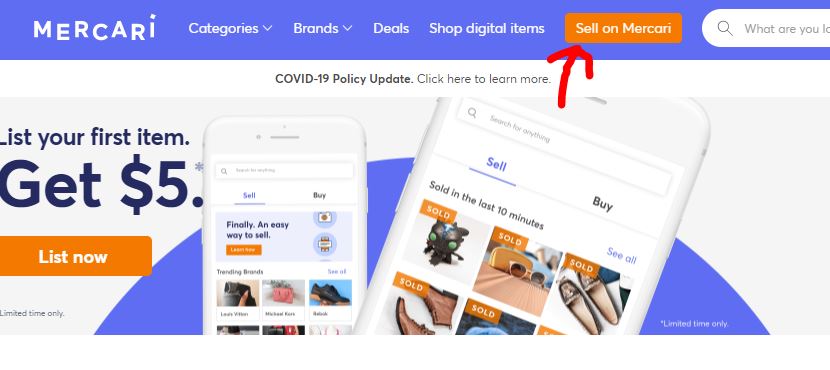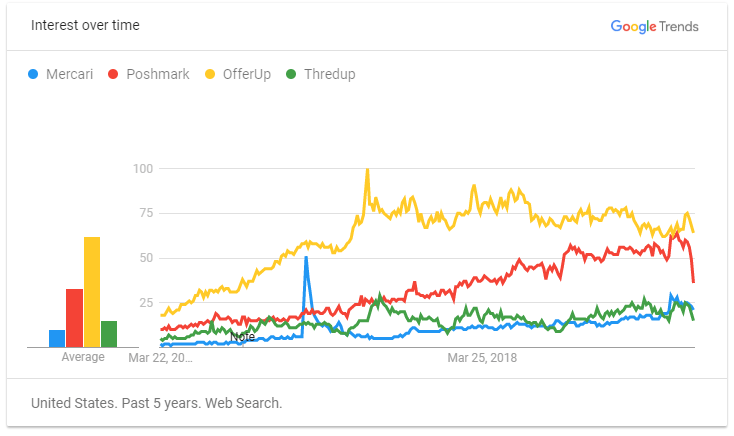
Many people are now leveraging apps to sell stuff and I think that’s a great boost for the economy. There are many platforms you can go to and the one we’ll be discussing today is called Mercari, a marketplace that originates from Japan. How does one make money with Mercari, what are the strengths of this marketplace and the downsides you need to look out for? This review will explain it all.
Mercari at a Glance
Dubbed as the ‘flea market app’, Mercari entered the US market in 2014 and has been downloaded over 30 million times since. The app allows communities to buy and sell unused, second-hand items that are still valuable in the following categories;
- Women Fashion
- Men Fashion
- Toys and Baby Products
- Electronics
- Home & Living
- Beauty
- Sports
- Vintage
- Handmade
So if you find anything suitable at home or in your closet, you can consider using this platform as long as they aren’t prohibited goods like weapons, guns or counterfeit items.
How to Sell on Mercari
To get started, go to the website or launch the app and click the orange button that says “Sell on Mercari”. This will bring you to a listing page where you can fill out all the necessary product information such as photos, title, description, shipping, and price.

For beginners, you can list up to 100 items but the threshold changes after a few sales, allowing you to sell more products. Upon receiving an order, a shipping label will be emailed for you to print and attach to the package.
When the buyer receives and is satisfied with the purchase, the sales payment will be released and deposited into your balance. This fund can be used to buy stuff on Mercari or cash out through a checking account. You will also receive ratings from customers reflecting the overall service that you’ve provided.
In order to boost sales, you’re encouraged to submit as many pictures as possible, provide detailed information about the product using keywords, and apply drop prices to attract buyers’ attention. Overall, the entire process is similar to selling on eBay or any other eCommerce platform.
For a limited amount of time, Mercari is offering a $5 coupon for your first listing, so head over to the site if you’ve something interesting to sell. Alternatively, you can also check the following sites or apps for more options on how to sell your junk for cash.
- Bookscouter – A book reselling platform that buys your old textbooks and fiction and sells them to other second-hand book vendors. You can check the value of the books by scanning the ISBN code using their mobile app. Newer books tend to fetch higher values than older ones.
- Declutter – An online marketplace that buys and sells used electronics and media such as gently-used phones and tech gadgets, CDs, DVDs, games and books, and even Lego toys (the original ones). You could earn anywhere between 10% to 60% return from the trading.
- Facebook Marketplace – A well-known social marketplace for people to buy-and-sell used items of any kind. If you live in an active community, you should be able to find a marketplace in your local area to join.
- OfferUp – A popular mobile selling app that gets about 17 million visitors each month. You can list for free using the mobile app and sells any gently used items from your house. The platform costs $2 to boost each listing and takes a 7.9 % fee from your sales transaction.
- Poshmark – A popular second-hand marketplace to trade clothing from women, men, and children as well as home products. It’s widely used by female users and every seller gets their own free boutique when they create listings for their items. Poshmark takes a $2.95 commission on all sales under $15 and a 20% commission on any sales above $15.
- Swappa – An online marketplace for used-digital goods like laptops, phones, video games, and consoles. Listing is free and in most cases, the buyers will bear the cost when the product is sold. It costs about $5 to boost your listing on the search.
- ThredUp – A fashion platform for people to buy and sell gently used women and children’s clothing, shoes, bags, maternity as well as jewelry. You can make anywhere between 5% to 80% off a sale, but keep in mind that it only accepts about 40% of the items that you send in through the kit. The remaining 60% can either be returned or donated for charity.
- Tradesy –
The Advantages of Selling With Mercari
(1) Like most apps, Mercari is easy to use and you can literally do everything from the convenience of a smartphone. The free listing feature is also a big plus as it allows you to get as many items out there as possible to increase buying options and sales.
(2) Mercari’s prepaid shipping label comes with insurance coverage of $200 for items that are either lost or damaged during transit so that at least should give you some reassurance as a seller.
(3) If you carry a lot of branded goods, second-hand marketplaces are ideal platforms to sell because customers love buying them at low prices. Mercari organized products according to brand names so if a particular name exists in their listings, then we know there’s more or less market demand for that label.
(4) Every listing page comes with an in-house chat system. This is a great feature for customers to ask you questions and clarify things before placing any orders. When someone leaves you a query, Mercari will prompt you via email to respond.
The Downsides of Selling With Mercari
(1) Like any crowded marketplaces, the most challenging thing you will face is competition. According to Mercari, 10 billion items are sold every month with over 100,000 new items added each day. With that kind of humongous volume, it’s almost impossible to get any eyeballs for your products or be at the top of the listing. More so if you only list a few items on your page. It’s a pretty common sight to find people who haven’t sell anything even after posting for months.
(2) Apart from that, you’re also facing competition from other buy-and-sell apps. If you compare Mercari to other second-hand marketplaces, it may not be the most popular one amongst users. According to Google Trend, Mercari (in blue) has the lowest search volume compared to OfferUp and Poshmark.

(3) And then there’s the selling fee of 10% which I think can cause some dent to your profit. Now, I know the platform needs to make money to keep their business running but still, it’s a lot to pay for selling second-hand stuff. Other places, as I found out later, appear to charge more or less within that range too so I guess everywhere is going to be the same.
(4) Remember the chat system that was supposed to enhance communication between buyers and sellers? Well, it can also be abused by lowballers, trying to negotiate prices with you. As if second-hand prices aren’t affordable enough, these people will make life very difficult until they get what they want. Will you give in to them? I am guessing not.
(5) Lastly, there’s always the risk of getting your account closed or suspended if you don’t abide by the terms and conditions. This can occur in any type of disagreement and may be completely out of your control. Once you lose that foothold as a seller, there’s nothing to benefit from this platform anymore.
Is It Possible to Make Money with Mercari?
In short, you can absolutely make money, granted you have the desirable items that people want to buy on Mercari. By making an effort to update your listings frequently and be proactive in communication, you’re bound to find a buyer.
Some people have claimed to make a few thousand in just several months, but it’s unlikely this scenario will happen to everyone due to high competition and product scarcity. It’s a nice platform to resell unused items for sure, but I wouldn’t rely on it to generate any long term cash.
Come to think of it, I wouldn’t count the earnings as profit-making either. Unless the product is obtained for free, you’re merely recouping what you’ve spent in the first place at depreciation value.
To make it worthwhile, you actually need to learn how to flip products and do so in large quantities to make any substantial profit. However, if you only have that much junk to sell and prefer not to deal with any shipping orders, then affiliate marketing may be better suited for you instead.
It’s a legit online income model that lets you earn sales commissions by referring customers to recommended products and services. Nowadays, affiliate programs are widely available in any niches that sell through eCommerce.
All you need is a custom domain and a blog to get started – no inventory, no order processing and no dealing with customers. How about that for an online business idea? 🙂 If you want to learn more about becoming an affiliate marketer, join my recommended training platform to claim your free blog and I will personally walk you through the process.
Have you sold anything on Mercari or similar marketplaces? Please share your thoughts and experience in the comment space below.

I’m really impressed by this review. Mercari looks like a cool app because it allows communities to buy and sell unused, second-hand items that are still valuable. I like that it comes with insurance coverage for items that are either lost or damaged during transit; noticed that not all companies are like that.
Mercari sounds very promising but is largely dependent on the exact niche you are marketing. If you have access to a large number of desirable items then you should give Mercari a serious look. It may be a nice alternative to other resell shops and may lead to some customers that you may not have made on other sites. I look at it as another marketing vehicle.